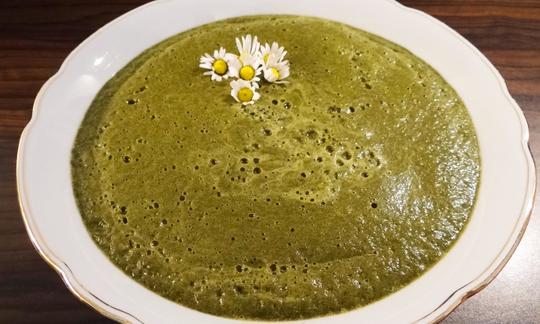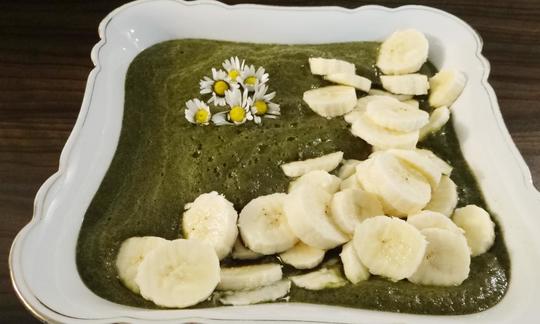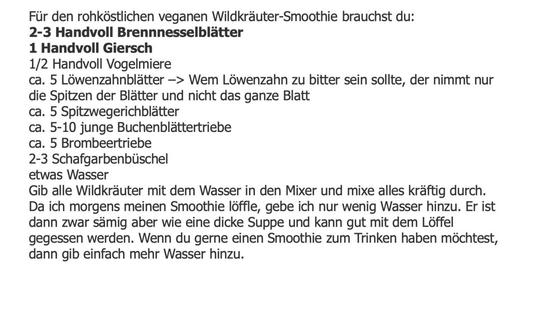Raw vegan wild herb smoothie
raw-vegan
Ingredients (for servings, )
Equipment
- blender or hand-held blender / immersion blender
Type of preparation
- food preparation without heating
- blend
Preparation
Put all the wild herbs in the blender with a little water and mix well. If you want to eat the smoothie with a spoon, just add a little water. It will be creamy but like a thick soup, it can be eaten with a spoon. If you want to drink a smoothie, just add more water.
In the original recipe, the quantities are not so precise, here it says for the amount we specified for 2 portions: 2-3 handfuls of nettle leaves, 1 handful of ground elder, ½ handful of chickweed, approx. 5 dandelion leaves, approx. 5 ribwort plantain leaves, approx. 5-10 young beech leaf shoots, approx. 5 blackberry shoots and 2-3 yarrow bunches.
Note from the author: If dandelion is too bitter for you, only use the tips of the leaves and not the whole leaf.
|
Nutritional Information per person
Convert per 100g
|
2000 kcal | |
|---|---|---|
| Energy | 6.0 kcal | 0.3% |
| Fat/Lipids | 0.06 g | 0.1% |
| Saturated Fats | 0.00 g | 0.0% |
| Carbohydrates (inc.dietary fiber) | 1.1 g | 0.4% |
| Sugars | 0.03 g | 0.0% |
| Fiber | 0.52 g | 2.1% |
| Protein/Albumin | 0.35 g | 0.7% |
| Cooking Salt (Na:1.7 mg) | 4.2 mg | 0.2% |
| Essential micronutrients with the highest proportions | per person | 2000 kcal | |
|---|---|---|---|
| Vit | Vitamin K | 42 µg | 55.0% |
| Min | Copper, Cu | 0.05 mg | 5.0% |
| Min | Manganese, Mn | 0.08 mg | 4.0% |
| Elem | Calcium, Ca | 35 mg | 4.0% |
| Vit | Vitamin C (ascorbic acid) | 3.5 mg | 4.0% |
| Vit | Vitamin A, as RAE | 14 µg | 2.0% |
| Elem | Potassium, K | 38 mg | 2.0% |
| Vit | Riboflavin (vitamin B2) | 0.01 mg | 1.0% |
| Vit | Folate, as the active form of folic acid (née vitamin B9 and | 1.2 µg | 1.0% |
| Min | Iron, Fe | 0.17 mg | 1.0% |
Detailed Nutritional Information per Person for this Recipe
The majority of the nutritional information comes from the USDA (US Department of Agriculture). This means that the information for natural products is often incomplete or only given within broader categories, whereas in most cases products made from these have more complete information displayed.
If we take flaxseed, for example, the important essential amino acid ALA (omega-3) is only included in an overarching category whereas for flaxseed oil ALA is listed specifically. In time, we will be able to change this, but it will require a lot of work. An “i” appears behind ingredients that have been adjusted and an explanation appears when you hover over this symbol.
For Erb Muesli, the original calculations resulted in 48 % of the daily requirement of ALA — but with the correction, we see that the muesli actually covers >100 % of the necessary recommendation for the omega-3 fatty acid ALA. Our goal is to eventually be able to compare the nutritional value of our recipes with those that are used in conventional western lifestyles.
| Essential fatty acids | per person | 2000 kcal |
|---|---|---|
| Alpha-Linolenic acid; ALA; 18:3 omega-3 | 0.00 g | < 0.1% |
| Linoleic acid; LA; 18:2 omega-6 | 0.00 g | < 0.1% |
| Vitamins | per person | 2000 kcal |
|---|---|---|
| Vitamin K | 42 µg | 55.0% |
| Vitamin C (ascorbic acid) | 3.5 mg | 4.0% |
| Vitamin A, as RAE | 14 µg | 2.0% |
| Riboflavin (vitamin B2) | 0.01 mg | 1.0% |
| Vitamin B6 (pyridoxine) | 0.01 mg | 1.0% |
| Folate, as the active form of folic acid (née vitamin B9 and | 1.2 µg | 1.0% |
| Thiamine (vitamin B1) | 0.00 mg | < 0.1% |
| Niacin (née vitamin B3) | 0.04 mg | < 0.1% |
| Pantothenic acid (vitamin B5) | 0.00 mg | < 0.1% |
| Vitamin E, as a-TEs | 0.05 mg | < 0.1% |
| Essential macroelements (macronutrients) | per person | 2000 kcal |
|---|---|---|
| Calcium, Ca | 35 mg | 4.0% |
| Potassium, K | 38 mg | 2.0% |
| Magnesium, Mg | 4.9 mg | 1.0% |
| Phosphorus, P | 6.5 mg | 1.0% |
| Sodium, Na | 1.7 mg | < 0.1% |
| Essential trace elements (micronutrients) | per person | 2000 kcal |
|---|---|---|
| Copper, Cu | 0.05 mg | 5.0% |
| Manganese, Mn | 0.08 mg | 4.0% |
| Iron, Fe | 0.17 mg | 1.0% |
| Zinc, Zn | 0.08 mg | 1.0% |
| Selenium, Se | 0.03 µg | < 0.1% |
You don't need to buy the ingredients for the raw vegan wild herb smoothie, you can simply collect them yourself.
Nutrient profile: Since there were not enough confidential ingredient sources for the various wild plants at the time of research, the ingredient table does not provide representative information.
Nettle as an ingredient: Some people disdain it as a weed, while others use nettles as a medicinal plant because of their ingredients. But this prevailing ambivalence does not change the fact that nettles are a culinary enrichment for everyone's kitchen. The tips of nettles' shoots taste similar to spinach.
Ground elder: For some, ground elder is a weed that is difficult to control, while others use the old wild herb as a vegetable plant. Raw, ground elder tastes vaguely like parsley. You can also taste a carrot aroma. When cooked, the taste is reminiscent of spinach.
Chickweed: One of the The plant, which belongs to the carnation family, is often eaten as a salad plant due to its high vitamin and mineral content. Chickweed tastes slightly reminiscent of peas and corn. It is used medicinally to treat persistent coughs or to support rheumatism.
Dandelion: The leaves and yellow flowers as well as the root of the common dandelion are used in cooking, even raw. Young, fresh dandelion leaves have a slightly bitter taste. They can be eaten raw from March to June as a salad delicacy (Austria: "Röhrlsalat") or cooked as a vegetable. All of the vitamins and minerals they contain are many times higher than in lettuce.
Ribwort plantain: Ribwort plantain is used as a salad and as a medicine due to its anti-inflammatory and antibacterial effects. The tender, freshly sprouted leaves have a slightly mushroomy, quite dominant taste. The taste is best developed in combination with other edible wild herbs.
Beech leaf shoots: The young leaves of the beech tree that grow after the shoots have emerged are edible. They have a slightly sour taste and are suitable as an ingredient in salads and smoothies, for example.
Blackberry shoots: It is not only the blackberry fruit that is edible and has medicinal properties. Young, soft blackberry shoots are suitable as an ingredient in salads in early spring, for example. The taste of the newly unfolded leaves is sour and bitter. The use of blackberry leaves as a medicinal remedy has been known for a long time. Blackberry leaf tea is used as a supportive treatment for colds thanks to its expectorant and expectorant properties.
Yarrow: The leaves of yarrow can be used as an ingredient in soups due to their delicate structure, whereas the stems and flowers are quite stubborn and tough when raw. The flowers are therefore usually dried and used as a seasoning, for example. The leaves taste slightly bitter, aromatic and somewhat reminiscent of chamomile.
Tips for collecting:
- Nettles: When choosing nettles, if you have collected them yourself, we recommend choosing young leaves because of their taste. When picking them, use protection for your hands, such as a thick cloth or gardening gloves.
- Ground elder: be careful, there is a risk of confusion! When collecting, avoid confusion with inedible and poisonous species such as spotted hemlock or broad-leaved Merk. Ground elder is easy to recognize by its triangular leaf stalk, with one edge rounded and the opposite side concave.
- Chickweed: Chickweed can be collected all year round. In Germany it is often found on over-fertilized or rich meadows, on roadsides, in parks or on the edge of agricultural land.
- Dandelion: In Central Europe, the common dandelion is a common wild herb found in meadows, on roadsides, in light forests and in gardens. The younger the common dandelion is, the less bitter substances it contains. The preferred months for collecting it are April and May. However, the different parts of the plant are in season practically all year round. There is no danger of confusion with similar-looking poisonous plants. Fresh dandelion leaves can rarely be bought at weekly markets, but more often in Turkish supermarkets.
- Ribwort plantain: It is best to harvest and collect it from the beginning of April to the end of August. It is often found in small meadows, on fields and field edges or on paths adjacent to the forest.
- Beech leaf shoots: Beech trees sprout from around April to May. The trees are widespread in our forests and are also often found in parks.
- Blackberry shoots: Blackberries are widespread and grow on the edges of meadows, pastures and fields, in parks and gardens, on footpaths and in the forest. The shoot tips and leaves of the young shoots can be harvested from May to September.
- Yarrow: Be careful, there is a risk of confusion! It is relatively harmless to confuse it with the so-called meadowfoam, as this is also an edible herb. The situation is different if you pick the poisonous spotted hemlock or giant hogweed instead of yarrow. As a fully grown plant, however, the spotted hemlock is not only significantly taller than the yarrow, but you can also identify it by the reddish spots around the stems. In addition, the spotted hemlock has a smell reminiscent of mouse urine. Although the giant hogweed is clearly different from the yarrow due to its leaves, it is sometimes confused due to its white umbel flowers. If you touch the plant with bare hands, you can get burns that last for weeks.
Meadows, (sheep) pastures, semi-dry grasslands, field and roadsides are the preferred locations for yarrow. Yarrow can be harvested from May to September.
Since yarrow belongs to the daisy family, sensitive people should enjoy it with some caution.
Consistency and fruit: Depending on whether you want to drink the smoothie or spoon it, add as much or as little water as you like. If you like it a little sweeter, you can also add fruit (such as apple or banana).







